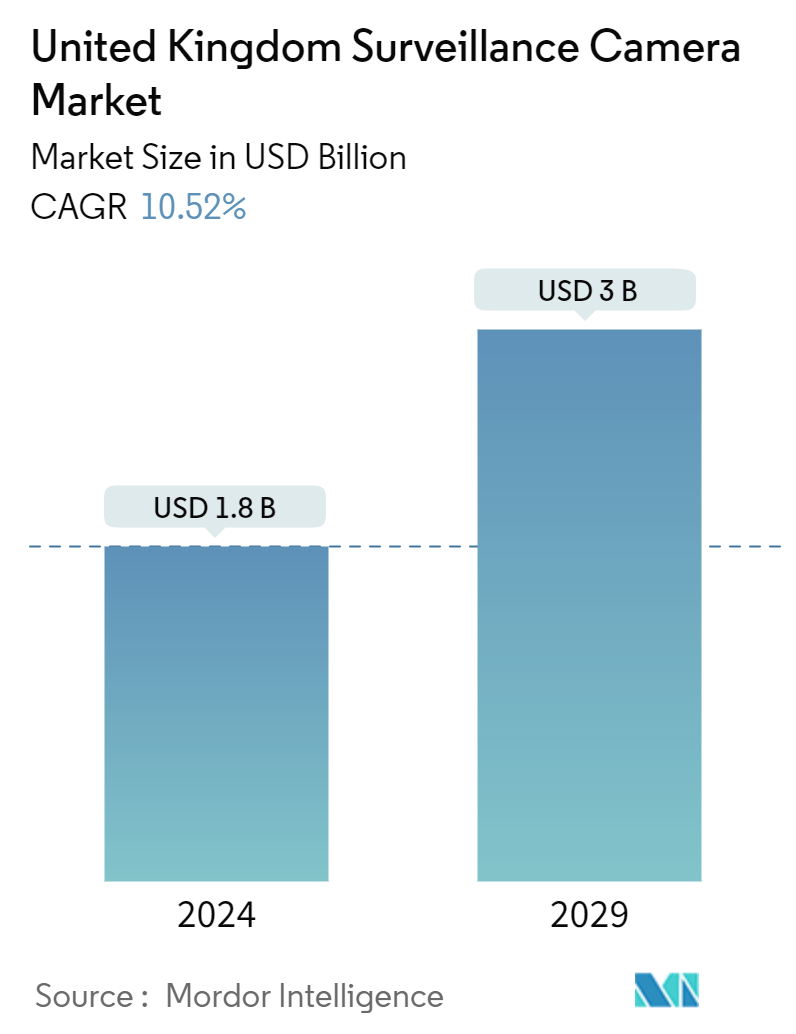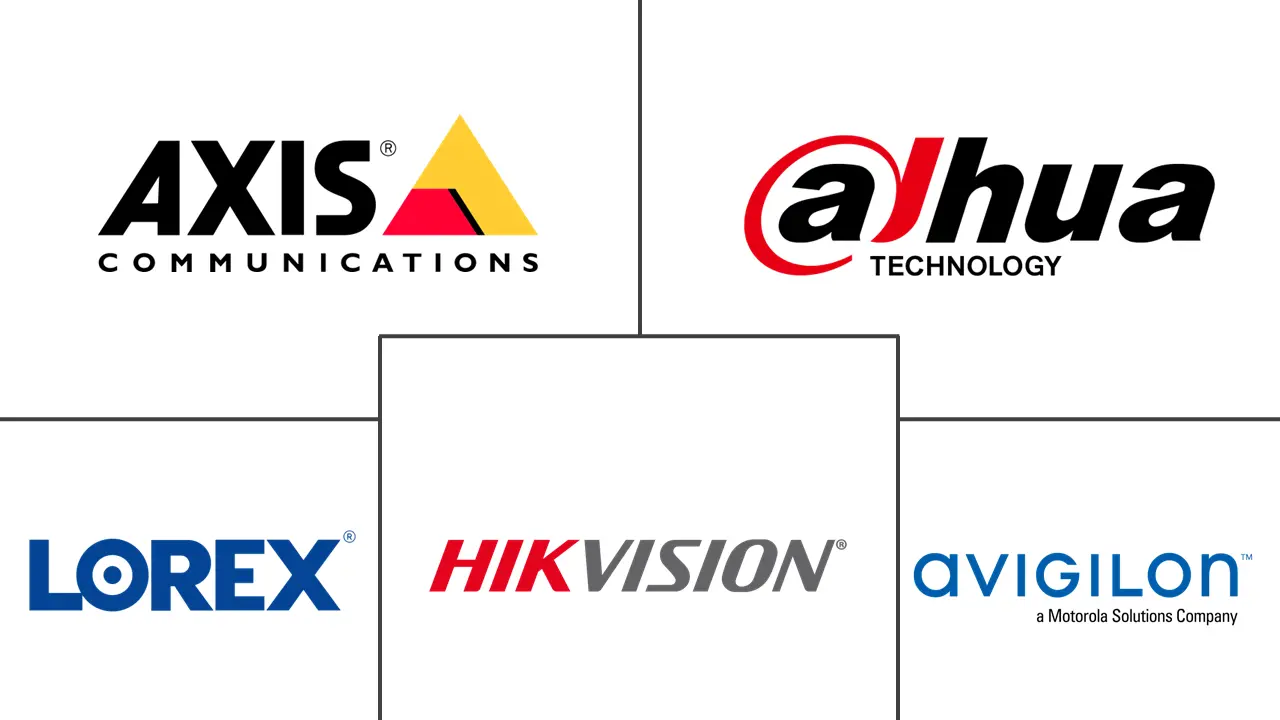Market Size of United Kingdom Surveillance Camera Industry

| Study Period | 2019 - 2029 |
| Base Year For Estimation | 2023 |
| Forecast Data Period | 2024 - 2029 |
| Market Size (2024) | USD 1.8 Billion |
| Market Size (2029) | USD 3 Billion |
| CAGR (2024 - 2029) | 10.52 % |
| Market Concentration | Low |
Major Players
*Disclaimer: Major Players sorted in no particular order |
United Kingdom Surveillance Camera Market Analysis
The United Kingdom Surveillance Camera Market size is estimated at USD 1.8 billion in 2024, and is expected to reach USD 3 billion by 2029, growing at a CAGR of 10.52% during the forecast period (2024-2029).
- The surge in crime rates, notably in violent and property-related offenses, has underscored the urgency of bolstering public safety measures. Surveillance cameras are pivotal, serving as a deterrent and a crucial investigative aid in pursuing criminals. These cameras find deployment not only in industrial settings but also in densely populated regions. Moreover, they can swiftly respond to unfolding events when integrated with smart devices such as alarms.
- Terrorism, whether domestic or international, looms large as a significant concern in the UK. Recent years have seen the UK grappling with a series of low-sophistication terror attacks in public areas, alongside the profound impact of larger-scale tragedies like the Manchester Arena attack. While such attacks remain infrequent, the specter of terrorism is ever-present, its unpredictability heightening concerns. Notably, public spaces and crowded locales are increasingly seen as prime targets. Emphasizing this, Martyn's Law underscores the pivotal role of surveillance cameras in bolstering counterterrorism efforts, enabling the close monitoring and tracking of suspicious activities.
- Further, advancements in camera technology, such as integration with AI, have propelled the adoption of surveillance systems. The country is witnessing excessive adoption of AI in several industries, including the security industry. In addition, several major companies are prioritizing integrating AI in surveillance cameras to improve video quality with enhanced resolution, night vision features, and sophisticated analytics.
- However, ongoing debates and discussions focus on the ethical implications of surveillance technology, including potential bias, discrimination, and the impact on vulnerable groups. Addressing these ethical concerns and developing appropriate governance frameworks is crucial for the responsible deployment of surveillance cameras.
- The Russia-Ukraine conflict has profoundly disrupted operations for foreign-owned and local companies in the region. The technology sector, in particular, has felt the brunt of this geopolitical turmoil. Companies are navigating through the aftermath of stringent trade and financial sanctions, a heightened cyber-attack risk, and challenges in retaining talent. Moreover, the conflict has exacerbated supply chain inefficiencies, leading to delays, labor shortages, transportation bottlenecks, and prolonged customs procedures. These inefficiencies come at a cost, ultimately driving up prices for end consumers.
United Kingdom Surveillance Camera Industry Segmentation
Surveillance cameras serve to monitor specific public areas, typically from a distance, and are often prominently displayed. The market size encompasses the revenue accrued from the sales of surveillance cameras in several end-user indistries that is sold by various vendors in the country. Further, the study also tracks the underlying growth trends and impact of macroeconomic factors on the market.
The United Kingdom surveillance camera market is segmented by type (analog based, IP based), by end-user industry (government, banking, healthcare, transportation and logistics, industrial, and others [education institutions, retail, and enterprises]). The report offers market forecasts and size in value (USD) for all the above segments.
| By Type | |
| Analog Based | |
| IP Based |
| By End-User Industry | |
| Government | |
| Banking | |
| Healthcare | |
| Transportation and Logistics | |
| Industrial | |
| Others (Education Institutions, Retail, and Enterprises) |
United Kingdom Surveillance Camera Market Size Summary
The United Kingdom surveillance camera market is experiencing significant growth, driven by the increasing need for enhanced public safety measures amid rising crime rates and the persistent threat of terrorism. Surveillance cameras are becoming essential tools for deterring crime and aiding investigations, with their deployment expanding beyond industrial settings to densely populated urban areas. The integration of advanced technologies, such as artificial intelligence, is further propelling the adoption of these systems, offering improved video quality, night vision, and sophisticated analytics. However, the market also faces challenges related to ethical concerns over surveillance practices, necessitating the development of governance frameworks to ensure responsible use.
The transition from traditional analog CCTV systems to advanced IP-based digital solutions is a notable trend in the UK surveillance camera market. IP cameras offer superior image quality, advanced analytics, and seamless integration capabilities, making them increasingly popular for mobile surveillance, particularly in public transport. The UK government's efforts to combat terrorism and organized crime are bolstered by the strategic installation of surveillance cameras in public spaces and critical infrastructure. These cameras play a crucial role in monitoring public areas, identifying suspicious activities, and assisting law enforcement. The market is characterized by a fragmented landscape with several global and regional players, who are actively engaging in strategic initiatives to maintain competitiveness and address the evolving security needs.
United Kingdom Surveillance Camera Market Size - Table of Contents
-
1. MARKET INSIGHTS
-
1.1 Market Overview
-
1.2 Industry Attractiveness - Porter's Five Forces Analysis
-
1.2.1 Threat of New Entrants
-
1.2.2 Bargaining Power of Buyers
-
1.2.3 Bargaining Power of Suppliers
-
1.2.4 Threat of Substitute Products
-
1.2.5 Intensity of Competitive Rivalry
-
-
1.3 Industry Value Chain Analysis
-
1.4 An Assessment of Macroeconomic Trends on the Market
-
-
2. MARKET SEGMENTATION
-
2.1 By Type
-
2.1.1 Analog Based
-
2.1.2 IP Based
-
-
2.2 By End-User Industry
-
2.2.1 Government
-
2.2.2 Banking
-
2.2.3 Healthcare
-
2.2.4 Transportation and Logistics
-
2.2.5 Industrial
-
2.2.6 Others (Education Institutions, Retail, and Enterprises)
-
-
United Kingdom Surveillance Camera Market Size FAQs
How big is the United Kingdom Surveillance Camera Market?
The United Kingdom Surveillance Camera Market size is expected to reach USD 1.8 billion in 2024 and grow at a CAGR of 10.52% to reach USD 3 billion by 2029.
What is the current United Kingdom Surveillance Camera Market size?
In 2024, the United Kingdom Surveillance Camera Market size is expected to reach USD 1.8 billion.

